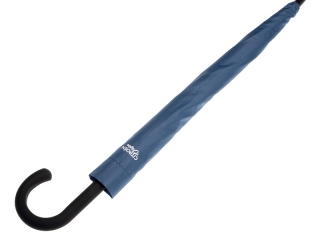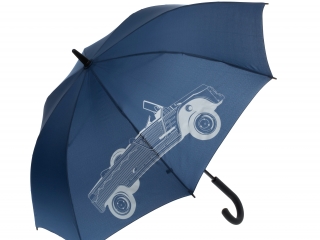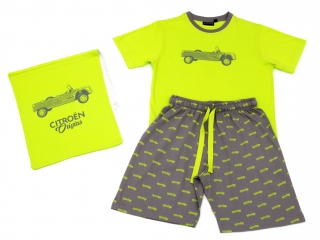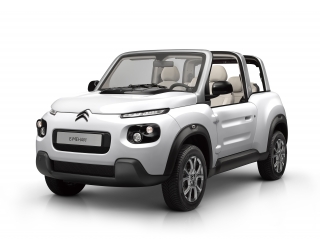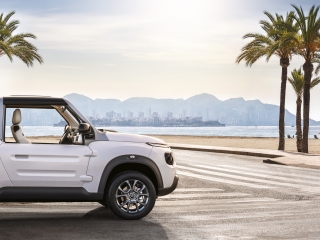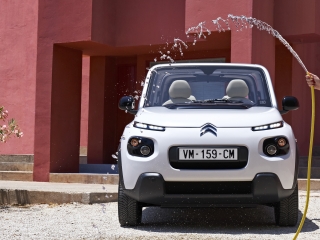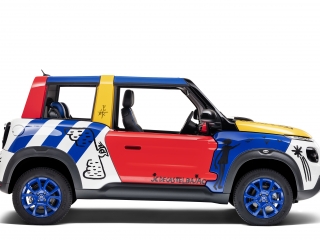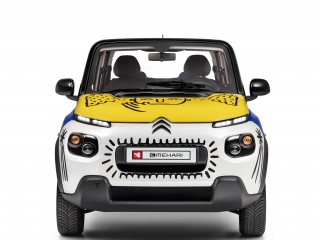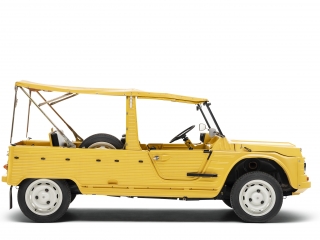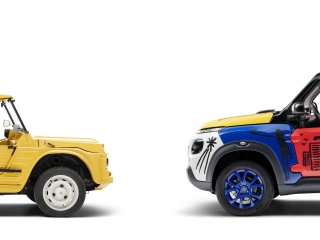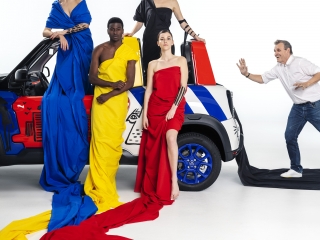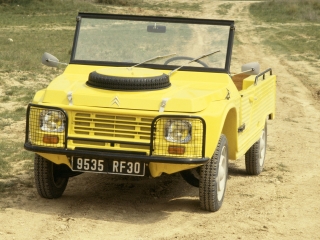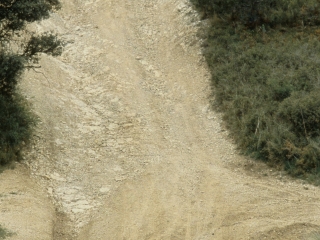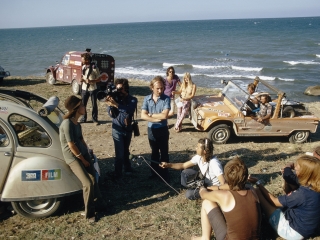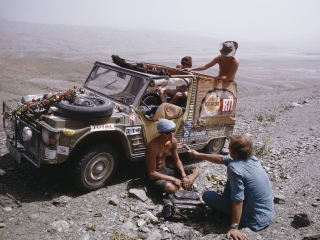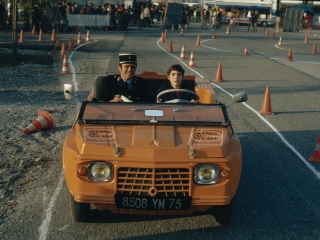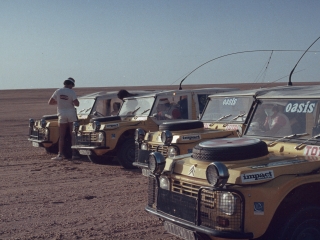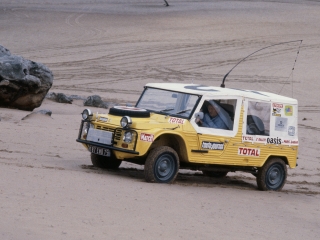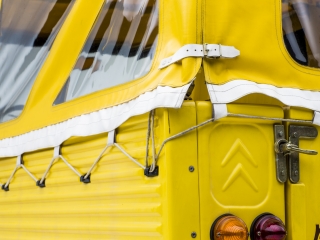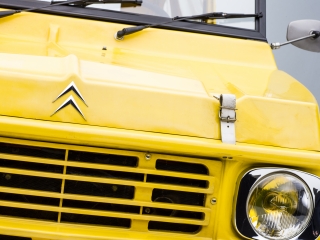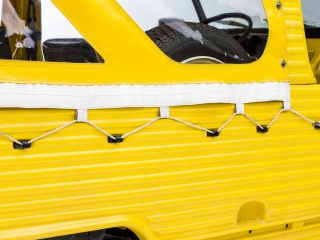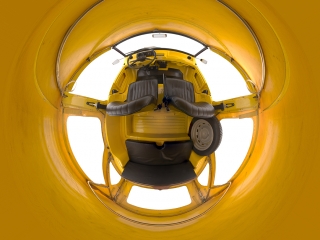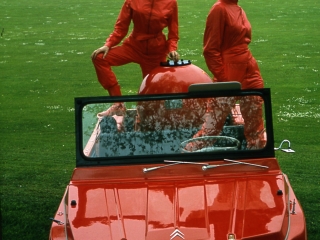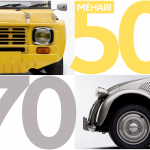
(English below)
Der Citroën Méhari wird 50. Auch ein halbes Jahrhundert nach seiner Markteinführung und zwei Jahre nach der Vorstellung des Citroën E-Mehari steht das außergewöhnliche Cabriolet für automobilen Mut auf französische Art. Anlässlich des runden Geburtstags hat Citroën den renommierten Designer Jean-Charles de Castelbajac beauftragt, ein exklusives E-Mehari „Art Car“ zu entwerfen.
Im Mai 1968 feierte der Citroën Méhari seine Weltpremiere. Zur selben Zeit entwarf der visionäre Designer Jean-Charles de Castelbajac, der selbst Teil der 68er-Bewegung in Paris war, seine erste Modekollektion. Nun symbolisiert die Partnerschaft die kreative Revolution, die Citroën und Jean-Charles de Castelbajac seit jeher antreibt.
Mit dem „Art Car“ bringt Jean-Charles de Castelbajac die französische Lebensart des neuen Citroën E-Mehari auf ganz besondere Weise zur Geltung. Das Optimismus und Popkultur ausstrahlende Kunstwerk ist ein Zeichen grenzenloser Kreativität.
Mai 1968: Ein Mythos entsteht
Während eine ganze Generation auf den Pariser Straßen mehr Freiheit forderte, überraschte Citroën am 11. Mai 1968 im französischen Deauville mit der Präsentation des Méhari – ein Fahrzeug mit hohem Freizeitwert, das seiner Zeit weit voraus war.
Das schlichte, vielseitige Cabriolet, das auf der Plattform der Citroën Dyane 6 gebaut worden ist, überzeugte durch seinen farbenfrohen, unprätentiösen Auftritt. Die von Roland de la Poype entwickelte leichte Karosserie bestand aus durchgefärbtem ABS-Kunststoff (525 Kilogramm) und war nicht rostanfällig. Zudem ließ sie sich außen wie innen mit einem simplen Wasserstrahl reinigen. Der Citroën Méhari wurde zum idealen Begleiter für Ausflüge ans Meer.
Mit seinen vielseitigen Eigenschaften – unter anderem ließ sich das Verdeck oberhalb des Karosseriegürtels komplett öffnen und die Windschutzscheibe war klappbar – fühlte sich der Citroën Méhari überall zu Hause. Zudem sorgte die große Bodenfreiheit für einzigartige Einsatzmöglichkeiten. 1979 kam eine Allradversion auf den Markt, die bis zu 60 Prozent steile Steigungen bewältigen konnte.
Darüber hinaus blickt der Citroën Méhari sowohl auf eine große Karriere in bekannten Kinofilmen (beispielsweise in „Der Gendarm von Saint-Tropez“ mit dem berühmten Schauspieler Louis de Funès) als auch bei bedeutenden Rallyes zurück (Lüttich-Dakar-Lüttich 1969, Paris-Kabul-Paris 1970, Paris-Dakar 1980).
Während der 19-jährigen Produktionszeit (bis 1987) wurden rund 145.000 Exemplare des Citroën Méhari gefertigt. Der Citroën Méhari war also auf Anhieb ein voller Erfolg und wurde über die Jahre hinweg zum Phänomen der Automobilgeschichte.
Dezember 2015: Die Geschichte geht weiter
Ende 2015 präsentierte Citroën den E-Mehari, ein rein elektrisch angetriebenes, viersitziges Cabriolet mit farbenfrohen Design, das an den legendären Citroën Méhari von 1968 erinnert. Angesagt, frei, unorthodox und auch ein wenig frech – das sind nur einige der Adjektive, die das neue Modell der Marke Citroën beschreiben. Der Citroën E-Mehari ist ein farbenfrohes Auto, das den Geist von Citroën aufs Beste verkörpert. Der Citroën E-Mehari ist ein “it-car”, das diejenigen verführt, die sich von anderen abheben, die voller Energie sind, Trends setzen und die Umwelt schonen.
Der Citroën E-Mehari übernimmt die stilistischen Merkmale der Marke. Er spiegelt die Positionierung von Citroën wider, andersartige, innovative Fahrzeuge zu entwickeln, die als Aushängeschild für französische Kreativität stehen. Die neueste LMP®-Batterie-Technologie (Lithium-Metall-Polymer) der französischen Bolloré-Gruppe wird im französischen Quimper hergestellt. Der Citroën E-Mehari wird im Werk von PSA in Rennes, Bretagne, produziert. Als erstes Elektrofahrzeug hat der Citroën E-Mehari deshalb das Prädikat „Origine France Garantie“ erhalten.
Die limitierte Sonderedition „Styled by Courrèges“ des neuen Citroën E-Mehari, die im vergangenen Spätsommer vorgestellt wurde, ist mit Hardtop, Seitenscheiben sowie einer Heckscheibe, die sich öffnen lässt, ausgestattet. Der neue Citroën E-Mehari wird so zum familientauglichen Stadtauto für den ganzjährigen Einsatz. Der hochwertige Innenraum wurde unter Beachtung typischer Markenzeichen vollständig umgestaltet. Das neue Armaturenbrett mit Dekor in Wagenfarbe sowie neue Sitze verleihen dem Fahrzeug einen moderneren Look. Der Einstieg in den Fond wird dank Easy-Entry-System erleichtert.
Auch das Thema Sicherheit wird im neuen Citroën E-Mehari großgeschrieben: Serienmäßig gehören vier Front- und vordere Seitenairbags, ABS und die elektronische Stabilitätskontrolle zur Ausstattung. Für ein entspanntes Fahrgefühl sorgen zudem das Reifendruckkontrollsystem, das automatisch einschaltende Abblendlicht sowie die Gurtwarneinrichtung für Fahrer- und Beifahrersitze. Dank der Zentralverriegelung wird das Fahrzeug diebstahlsicherer. Zu den Besonderheiten des neuen Citroën E-Mehari zählt ein akustisches Warnsignal für Fußgänger, das bei Geschwindigkeiten bis 30 km/h aktiv ist.
Die Preise beginnen bei 25.270 Euro für die Softtop-Version beziehungsweise bei 26.470 Euro für die Hardtop-Version.
1968 Méhari… 2018: E-Mehari
Für Jean-Charles de Castelbajac ist der Méhari „DIE Fahrzeug-Ikone seiner Generation”. Der Citroën Méhari sei mehr als nur ein Mythos, er habe die Fahrzeugwelt revolutioniert. Diesen Charakter wolle er bei seinem „Art Car“ durch das Spiel mit Farben, Rollen und Worten noch mehr hervorheben.
Das Kunstwerk von Jean-Charles de Castelbajac spielt auf gleich zwei Revolutionen an: Die Studentenbewegung im Mai 1968 spiegelte die Sehnsucht nach einer anderen Zukunft, Sorglosigkeit und Meinungsfreiheit wider. Zur gleichen Zeit begann mit der Präsentation des Citroën Méhari eine „automobile Revolution“. Das einzigartige Fahrzeug weckte die Lust nach einem neuen Lebensgefühl, das bei Ausflügen in die Natur ausgelebt wurde. Das Wort „Freiheit“ darf somit als Bindeglied zwischen dem Citroën Méhari und der 68er-Generation gesehen werden. Jean-Charles de Castelbajac entwarf nun ein „Art Car“ als grafisches Manifest – in Anlehnung an die Plakate vom Mai 1968.
Die farbenfrohe Gestaltung und die handgravierten Elemente des „Art Car“ stehen für Freiheit. Die Symbole sollen die Reisenden zu ihren Zielen führen, die manchmal utopisch sind, aber meist für Hoffnung, Pläne und den Wunsch, die Welt zu verändern, stehen.
Die chromatische Arbeit des Modedesigners vermittelt eine ansprechende Botschaft: Rot steht für Revolution und Leidenschaft, Gelb verkörpert die Ausstrahlung, die Lust zu erobern, Freundschaft und Brüderlichkeit. Blau erinnert an Elektrizität, azurblauen Himmel und ein positives Umfeld.
Für Arnaud Belloni, Direktor Marketing und Kommunikation Citroën, handelt es sich hierbei um eine natürliche und selbstverständliche Begegnung: „Der Citroën Méhari ist eine Ikone und das Auto par excellence, das Konventionen in Frage stellt. Im Mai 1968 präsentiert, verkörpert er 50 Jahre später die französische Popkultur. Um seinen runden Geburtstag zu feiern, haben wir seinen würdigen Nachfolger, den rein elektrisch angetriebenen Citroën E-Mehari, der Kreativität von Jean-Charles de Castelbajac anvertraut. Aus der Begegnung zwischen zwei kreativen, revolutionären Häusern ist ein Art Car voller Frische und Lebensfreude entstanden.”
Kontakt:
CITROËN DEUTSCHLAND GmbH
Presse und Öffentlichkeitsarbeit
Susanne Beyreuther
Telefon: 02203/ 2972-1412
E-Mail: susanne.beyreuther@citroen.com
NB: die Amicale hat schon früher ausführlich über den Méhari und dessen Geschichte berichtet – siehe unsere Méhari Artikel.
—–
50 Years of Citroën Méhari
(Translation by AMicale)
The Citroën Méhari turns 50, half a century after its market launch and two years after the launch of the Citroën E-Mehari, the extraordinary convertible still stands for automotive courage in the French style. On the occasion of the round birthday, Citroën commissioned the renowned designer Jean-Charles de Castelbajac to design an exclusive E-Mehari “Art Car”.
In May 1968 the Citroën Méhari celebrated its world premiere. At the same time, visionary designer Jean-Charles de Castelbajac, who himself was part of the 1968 movement in Paris, designed his first fashion collection. Now the partnership symbolizes the creative revolution that has always driven Citroën and Jean-Charles de Castelbajac.
With the “Art Car”, Jean-Charles de Castelbajac brings the French way of life of the new Citroën E-Mehari to the fore in a very special way. The work of art radiating optimism and pop culture is a sign of boundless creativity.
May 1968: A myth arises
While a whole generation demanded more freedom on the streets of Paris, Citroën surprised on 11 May 1968 in Deauville, France, with the presentation of the Méhari – a vehicle with high recreational value that was far ahead of its time.
The simple yet versatile convertible, which was built on the platform of the Citroën Dyane 6, convinced by its colorful, unpretentious appearance. The lightweight body developed by Roland de la Poype consisted of solid-colored ABS plastic (525 kilograms) and was not prone to rust. In addition, it could be cleaned inside and outside with a simple jet of water. The Citroën Méhari became the ideal companion for excursions to the sea.
The Citroën Méhari felt at home everywhere with its versatile features – among other things, the hood above the bodywork belt could be completely opened and the windscreen was foldable. In addition, the large ground clearance provided unique application possibilities. In 1979, an all-wheel-drive version was launched which was able to cope with gradients of up to 60 percent.
In addition, the Citroën Méhari can look back on a great career in well-known cinema films (for example in “The Gendarme of Saint-Tropez” with the famous actor Louis de Funès) as well as in important rallies (Liège-Dakar-Liège 1969, Paris-Kabul-Paris 1970, Paris-Dakar 1980).
During the 19-year production period (until 1987), around 145,000 copies of the Citroën Méhari were produced. The Citroën Méhari was therefore an immediate success and has become a phenomenon in automotive history over the years.
December 2015: The story continues
At the end of 2015, Citroën presented the E-Mehari, an all-electric, four-seater convertible with a colourful design reminiscent of the legendary Citroën Méhari of 1968. Fashionable, free, unorthodox and also a little cheeky – these are just some of the adjectives that describe the new model of the Citroën brand. The Citroën E-Mehari is a colourful car that embodies the spirit of Citroën in the best possible way. The Citroën E-Mehari is an “it-car” that seduces those who stand out from the crowd, are full of energy, set trends and protect the environment.
The Citroën E-Mehari adopts the stylistic features of the brand. It reflects Citroën’s positioning to develop different, innovative vehicles that stand for French creativity. The latest LMP® (lithium metal polymer) battery technology of the French Bolloré Group is manufactured in Quimper, France. The Citroën E-Mehari is produced in the PSA factory in Rennes, Brittany. The Citroën E-Mehari was therefore the first electric vehicle to be awarded the “Origine France Guarantee”.
The limited special edition “Styled by Courrèges” of the new Citroën E-Mehari, which was presented last late summer, is equipped with a hardtop, side windows and a rear window that can be opened. The new Citroën E-Mehari thus becomes a family-friendly city car for year-round use. The high-quality interior has been completely redesigned in accordance with typical trademarks. The new dashboard with body-colour decor and new seats give the vehicle a more modern look. Entry into the rear is made easier thanks to the easy-entry system.
Safety is also a top priority in the new Citroën E-Mehari: four front and front side airbags, ABS and electronic stability control are standard equipment. The tire pressure control system, the automatically switching on dipped beam and the seat belt warning system for driver and front passenger seats also ensure a relaxed driving experience. Thanks to the central locking system, the vehicle is more theft-proof. One of the special features of the new Citroën E-Mehari is an acoustic warning signal for pedestrians, which is activated at high speed.
(German) Prices start at 25,270 Euros for the softtop version and 26,470 Euros for the hardtop version.
1968 Méhari… 2018: E-mehari
For Jean-Charles de Castelbajac, the Méhari is “THE vehicle icon of its generation”. The Citroën Méhari is more than just a myth, it has revolutionised the vehicle world. He wants to emphasize this character even more in his “Art Car” by playing with colors, roles and words.
The work of art by Jean-Charles de Castelbajac alludes to two revolutions: The student movement in May 1968 reflected the longing for a different future, carelessness and freedom of expression. At the same time, an “automotive revolution” began with the presentation of the Citroën Méhari. The unique vehicle aroused the desire for a new attitude to life, which was lived out during excursions into nature. The word “freedom” can therefore be seen as a link between the Citroën Méhari and the 1968 generation. Jean-Charles de Castelbajac now designed an “Art Car” as a graphic manifesto – based on the posters of May 1968.
The colourful design and hand-engraved elements of the “Art Car” stand for freedom. The symbols should lead travellers to their destinations, which are sometimes utopian, but usually stand for hope, plans and the desire to change the world.
The fashion designer’s chromatic work conveys an appealing message: red stands for revolution and passion, yellow embodies charisma, the desire to conquer, friendship and brotherhood. Blue reminds of electricity, azure blue skies and a positive environment.
For Arnaud Belloni, Director of Marketing and Communication Citroën, this is a natural and natural encounter: “The Citroën Méhari is an icon and the car par excellence that challenges conventions. Presented in May 1968, 50 years later he embodies French pop culture. To celebrate his birthday, we have entrusted his worthy successor, the purely electrically powered Citroën E-Mehari, to the creativity of Jean-Charles de Castelbajac. The encounter between two creative, revolutionary houses has resulted in a kind of car full of freshness and joie de vivre.”
NB: the Amicale had been posting a number of articles on the Méhari and its history – find out more about the Méhari here.







